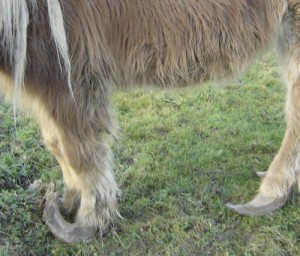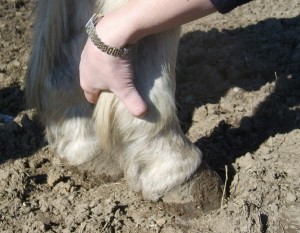Regular care of your equines hooves is imperative! Whether shod or left unshod you will need a qualified farrier to attend to your animals feet anywhere between every 4 to 10 weeks depending on the condition of the hoof, ground conditions and what work you are doing with him.
Hooves that are left to grow too long can have fatal and irreversible consequences for the animal. The pedal bone inside the hoof can start to rotate downwards which will mean excruciating pain. Donkeys and shetlands are not exempt from regular hoof care too and are by far the biggest victims of neglect we see with regard to hoof management.
Foals should also have a farrier to them from a month old as their feet grow very quickly, not only that, knowing how to pick up their feet on request is a vital part of their education. Do not leave training your horse to your farrier – a well behaved horse means a happier farrier!
Picking out the hooves regularly will allow you to check for things such as Thrush (foul smell), heat, objects in the hoof, loose shoes and condition of the frog.
Learn how to detect a digital pulse in the hoof (fetlock area) which may indicate laminitis or infection.
Unshod horses are more likely to have a faint pulse than shod ones. A thumping pulse is an indicator there is problem so it’s advisable to call the vet in this instance. Ask your farrier to show you how to remove a loose or twisted shoe in an emergency, it may save your horse from injuring itself.
Laminitis is a big problem especially with smaller hardy ponies that were never designed to eat a rich grass diet. It can affect all equines though so be aware of the following contributory causes – obesity, what you are feeding him, stress, concussion, infections, eating frosty grass, steroids in injections (ask your vet for non-steroid as steroids are given more often here than in UK). If you notice a strong digital pulse, a stance of him leaning backwards, difficulty or reluctance to walk or pick up the feet please call your vet. If you can get your horse to stand in buckets of ice cold water as soon as you notice signs of laminitis it can help to stop the symptoms progressing. Learn when the safer grazing times are in the day and stable your horse at high risk times. Grazing muzzles help limit the amount of grass ingested and are available in France from saddleries and mail order companies. Prevention is better than cure!



